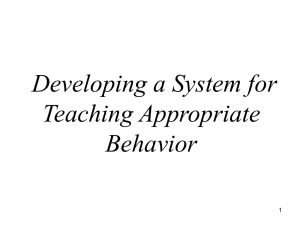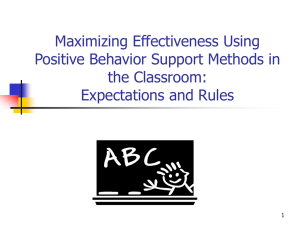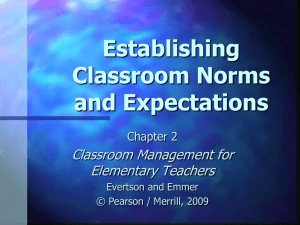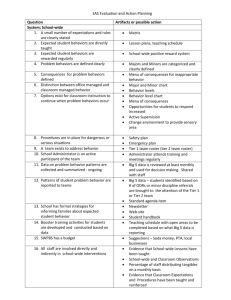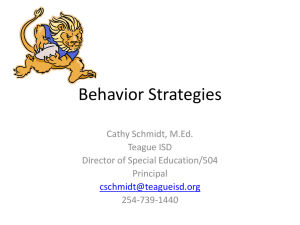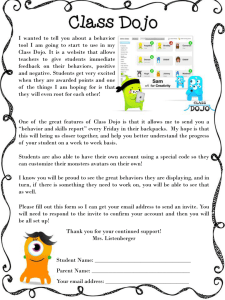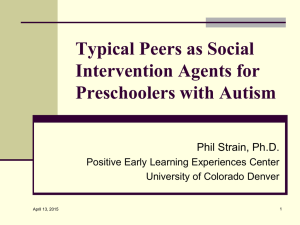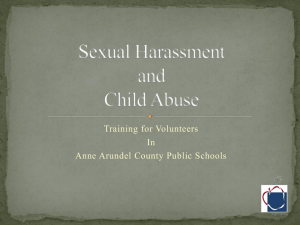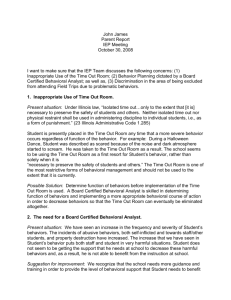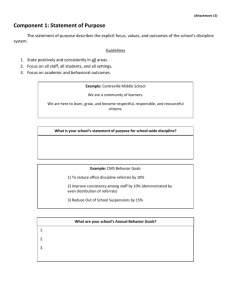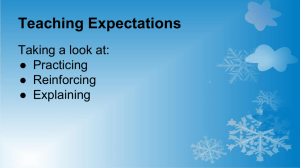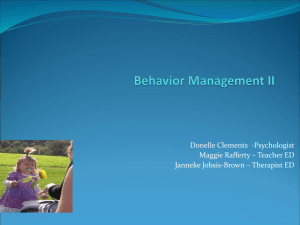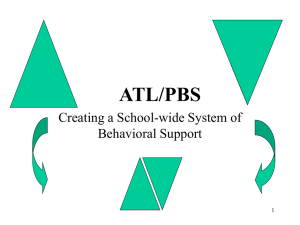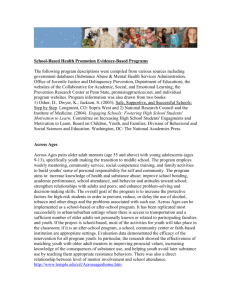G. Lesson Plans for Teaching Expectation/ Rules
advertisement
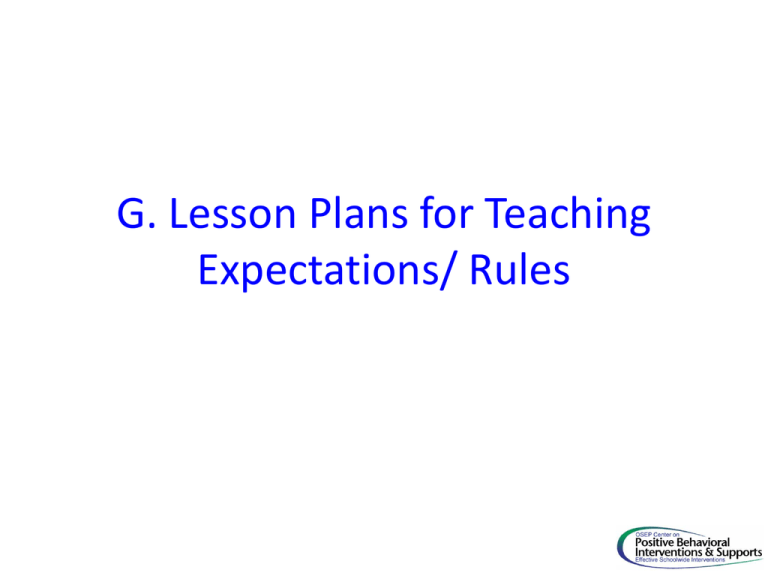
G. Lesson Plans for Teaching Expectations/ Rules Core Feature PBIS Implementation Goal G. Lesson 29. A behavioral curriculum includes Teaching expectations and rules Plans for Teaching 30. Lesson Plans include examples and non-examples Expectations/ Rules 31. Lessons use a variety of teaching strategies. 32. Lessons are embedded into subject area curriculum 33. Faculty/staff and students are involved in development & delivery of behavioral curriculum 34. Strategies to share key features of SWPBS program with families/community are developed and implemented. Objectives • Understand why and how to teach appropriate behavior • Identify how to develop lesson plans for teaching school-wide expectations and rules • Identify how to embed expectations in the curriculum • Explore creative ways to teach behavior • Understand how to use data to make decisions about teaching Developing a System for Teaching Appropriate Behavior Once you have developed school-wide expectations, it is not enough to just post the words on the walls of the classroom… YOU MUST TEACH THEM! Behavioral Errors • More often occur because: Students do not have appropriate skills- “Skill Deficits” Students do not know when to use skills Students have not been taught specific classroom procedures and routines Skills are not taught in context “If a child doesn’t know how to read, we teach.” “If a child doesn’t know how to swim, we teach.” “If a child doesn’t know how to multiply, we teach.” “If a child doesn’t know how to drive, we teach.” “If a child doesn’t know how to behave, we… …teach? …punish?” “Why can’t we finish the last sentence as automatically as we do the others?” (Herner, 1998) Why Develop a System for Teaching Behavior? • Behaviors are prerequisites for academics • Procedures and routines create structure • Repetition is key to learning new skills: • For a child to learn something new, it needs to be repeated on average of 8 times • Adults average 25- Joyce and Showers, 2006 • For a child to unlearn an old behavior and replace with a new behavior, the new behavior must be repeated on average 28 times (Harry Wong) Why Develop a System for Teaching Behavior? • We can no longer assume: • Students know the expectations/rules and appropriate ways to behave • Students will learn appropriate behaviors quickly and effectively without consistent practice and modeling Why Develop a System for Teaching Behavior? • We must assume: • Students will require different curricula, instructional modalities, etc… to learn appropriate behavior • We need to teach expectations/rules and appropriate behaviors as effectively as we teach academic skills Teaching Academics & Behaviors ADJUST for Efficiency MONITOR & ACKNOWLEDGE Continuously DEFINE Simply MODEL PRACTICE In Setting How Do We Teach Behavior? • Introductory Events – Teaching school to expectations and rules • On-going Direct Instruction – Specially designed lessons, character education • Embedding in Other Curriculum • Booster Trainings • Keeping it Out There – Visual Displays – posters, agenda covers – Daily announcements Introductory Events • All faculty and students participate • Decide on method that will be most effective for your school • Consider Importance/Impact - Activity/event should be a high priority… not given a few minutes in some other activity Creative Ideas: “Putting it into Practice” • Provide students with a script that includes actions and words expected • Rotate students through different settings-Teach the behaviors in the setting where the behaviors are expected to occur • Have classes compete to come up with unique ideas (student projects, bulletin boards, skits, songs, etc…) • Recognize staff for creative activities • Video students role-playing to teach expectations and rules and show during morning show Specially Designed Lessons • Provide initial lesson plans and/or lesson plan format for teachers to begin teaching behavior • Build on what you have (I.e. character ed.) • Develop a system for expanding behavior lesson plan ideas throughout the year • Determine the minimum requirements for teaching behavior (i.e. how often) Lesson Plans: Two Levels • Level 1: Concept Development (Expectations) – Broad expectations – Applicable to all settings • Level 2: Skills (Rules) – Observable behaviors – Rules for specific settings *****Lessons must be taught in setting that behavior occursFor example, if you are teaching cafeteria rules, students need to be in the cafeteria ******* Expectations & behavioral skills are taught & recognized in natural context Strategies for Success • Describe specific, observable behaviors for each expectation • Plan for modeling the desired behaviors • Provide students with written and graphic cues in the setting where the behaviors are expected • Acknowledge efforts • Plan to re-teach and restructure teaching • Allow students to participate in the development process • Use “teachable” moments that arise in core subject areas and in non-academic times Why Embed Expectations into Curriculum? •Behavior curriculum does not have to be separate •Helps to eliminate time crunches •Provides a rationale for student- helps students to see how the expectations fit into everyday life •Meets best practices approach -Hands on activities -Meets all learning styles (oral, visual, kinesthetic) -Higher order learning activates (synthesize, analyze, etc.) Embedding Expectations into Current Daily Curriculum Social Studies •Have students research different cultures to find out how they define “Respectful” •Talk about how different historical events occurred because of conflict and come up with solutions on how the conflict could have been resolved Embedding Expectations into Current Daily Curriculum Language Arts and Reading •Use a novel that has an expectation as a theme •Discuss characters in a novel and how they did not show respect, then have the students write the story with the character showing respect •Have the students develop their own expectations and/or rules and then have them write a persuasive essay or debate why theirs should be used instead of the school’s Embedding Expectations into Current Daily Curriculum Fine Arts (Music, Art, Computers, Graphics) •When choosing a school play, choose one with a theme centered around one of the school expectations or write your own play •Have the students compose a song/rap with the expectation •Have students come up with a campaign for promoting expectations to the entire student body Embedding Expectations into Current Daily Curriculum •Science and/or Math •Have students develop a hypothesis about what they think are the top behavior problems at school. Have them survey students, parents, & teachers; make graphs; and reach a conclusion about the hypothesis •Have the students count the number of tickets redeemed monthly for prizes & graph them. You can include ratio of number of tickets to student, # of tickets per teacher, etc. Activity 7 Current Practice • How does your school teach expectations? • How do you use “best practices” to teach social skills? – Teach directly in settings ? (i.e. bus expectations taught on bus) – Faculty and Staff Model appropriate behavior? • How would you start to embed into subject area curriculum? • How will lessons be taught throughout the school year? • Review Examples • Define Action Steps

